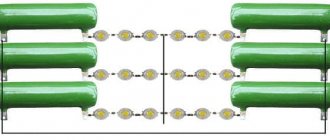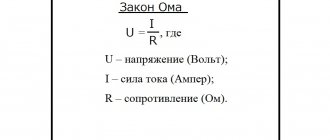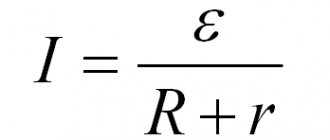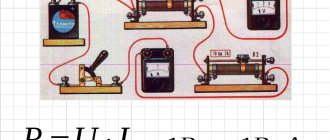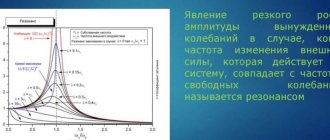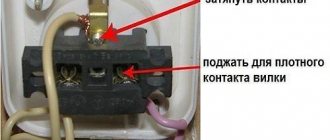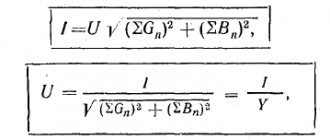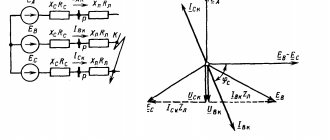Each material has a set of properties that determine its further characteristics. One of these qualities is resistance to mechanical loads, which is called ultimate stress. This concept refers not only to the destruction of the material at the fracture point, but also to the appearance of residual deformation. In other words, it is resistance to external forces that lead to weakening of strength. The article talks about what such voltage is, how it is calculated and how it is determined.
General information.
Calculations of pipes and connecting parts for strength are carried out according to the nominal permissible stresses [σ]. Nominal permissible stresses [σ] are determined by the formulas: - for carbon, low-alloy, ferritic, austenitic-ferritic, martensitic steels and iron-nickel alloys
— for austenitic chromium-nickel steel, aluminum, copper and their alloys
When determining permissible stresses for low- and medium-temperature pipelines, long-term strength characteristics σ2*105/t and σ1/2*105/t In the absence of data on the conditional yield strength at 1% permanent elongation, it is permissible to use the value of the conditional yield strength at 0.2 % residual elongation σ0.2/t, it is allowed to take the safety factor for σ0.2/t equal to 1.3 instead of 1.5. Allowable stresses for titanium alloys are calculated using the formula
where the coefficient is taken: - for titanium sheets and rolled pipes 2.6; — for titanium rods and forgings 3.0. In the absence of data on the yield strength and long-term strength, the permissible stress for aluminum, copper and their alloys is calculated using the formula
where the coefficient is taken: - for aluminum, copper and their alloys 3.5; — for aluminum casting alloys 7.0. If the permissible stress for operating conditions is determined by formula (5.4), then for pipelines made of aluminum, copper and their alloys, the permissible stress during testing is calculated using the formula
where the coefficient is taken: - for aluminum, copper and their alloys 1.8; — for aluminum casting alloys 3.5.
It is recommended to take standard values in accordance with reference and scientific and technical literature.
For steel pipelines operating under creep conditions at different design temperatures, it is allowed to take as the permissible stress , calculated by the formula
where , , …, are the duration of periods of operation of the pipeline with the calculated wall temperature, respectively, , …, , h; , , ..., - nominal permissible stresses for the design service life at temperatures, respectively, , ..., , MPa; — exponent in the equations of long-term strength of steel (for alloyed heat-resistant steels it is recommended to take 8); — total design service life, hours. Permissible stresses are taken in temperature ranges of no more than 30°C. If it is necessary to determine equivalent permissible stresses for a temperature range of more than 30°C, the average value of the exponent should be used according to experimental data with a test base of no more than 0.1 of the service life, but not less than 10 hours.
For materials and structures that are not specified in this standard, reference and experimental data are used.
Group I - workshops without increased danger
- work occurs at normal temperatures up to +5 degrees and relative air humidity up to 75% (according to the rules for the design of electrical installations (PUE);
- floor coverings are made of non-conductive materials: tiles, wood, linoleum and similar;
- minimum electrical installations to be grounded;
- there are no complex metal structures;
- there is no conductive dust in the air or on surfaces;
- Such premises are characterized by large areas and low space fill ratio;
- It is allowed to work with electrical devices with a voltage of 0.23 kV.
Area without increased danger for personnel
Examples: office premises, control rooms, utility rooms, computer centers, administration and management offices.
Principles for classifying premises according to the danger of electric shock.
Conductive dust settles on the wires, creates paths for blocking the wires, and the insulation is destroyed. A person with dusty hands conducts electricity better than someone with clean, dry hands.
Expert opinion
It-Technology, Electrical power and electronics specialist
Ask questions to the “Specialist for modernization of energy generation systems”
Classification of premises according to the degree of electric shock. What circumstances of the possible inclusion of a person in the circuit of electric current flow determine the choice of the maximum permissible levels of touch voltage and current through the human body. Ask, I'm in touch!
Rated permissible voltage calculators.
Initial data.
Enter the minimum tensile strength (tensile strength) value at the design temperature (G1)
Convert units of measurement online
Enter the minimum yield strength at design temperature (G2)
Convert units of measurement online
Enter the minimum proof strength (stress at which permanent elongation is 0.2%) at design temperature (G3)
Convert units of measurement online
Enter a conditional long-term strength limit for a resource of 2·100000 h at the design temperature (G4)
Convert units of measurement online
Enter a conditional tensile creep limit that causes a deformation of 1% in 2 10000 hours at the design temperature (G5)
Convert units of measurement online
Calculation for low and medium temperature pipelines.
Calculation of nominal permissible stress for carbon, low-alloy, ferritic, austenitic-ferritic, martensitic steels and iron-nickel alloys.
Result of calculation of permissible stress at design temperature (G0)
Formula for calculating the permissible stress at the design temperature:
Download the result of calculating the permissible stress at the design temperature:
Share a link to the calculation:
Calculation of nominal permissible stress for austenitic chromium-nickel steel, aluminum, copper and their alloys.
Calculation result of permissible stress at design temperature (G03)
Formula for calculating the permissible stress at the design temperature:
Download the result of calculating the permissible stress at the design temperature:
Share a link to the calculation:
Calculation for high-temperature pipelines.
Calculation of nominal permissible stress for carbon, low-alloy, ferritic, austenitic-ferritic, martensitic steels and iron-nickel alloys.
Result of calculation of permissible stress at design temperature (G01)
Formula for calculating the permissible stress at the design temperature:
Download the result of calculating the permissible stress at the design temperature:
Share a link to the calculation:
Calculation of nominal permissible stress for austenitic chromium-nickel steel, aluminum, copper and their alloys.
Result of calculation of permissible stress at design temperature (G04)
Formula for calculating the permissible stress at the design temperature:
Download the result of calculating the permissible stress at the design temperature:
Share a link to the calculation:
Reference data on permissible stresses.
Data RD 10-249-98 Standards for calculating the strength of stationary boilers and steam and hot water pipelines.
Table 2.1. Nominal permissible stresses [σ] for carbon and manganese steels, independent of the design life, MPa.
| , °С | steel grade | ||||||||
| St2kp | St3kp | St2sp, St2ps | St3sp, St3ps | St4ps, St4sp | S3Gps | 22K | 14GNMA | 16GNM, 16GNMA | |
| From 20 to 50 | 124 | 133 | 130 | 140 | 145 | 150 | 170 | 180 | 190 |
| 150 | 106 | 115 | 112 | 125 | 129 | 134 | 155 | 179 | 181 |
| 200 | 111 | 100 | 117 | 121 | 125 | 147 | 175 | 176 | |
| 250 | 80 | 102 | 86 | 107 | 111 | 115 | 140 | 171 | 172 |
| 275 | 102 | 106 | 109 | 135 | 170 | 169 | |||
| 300 | 70 | 98 | 103 | 130 | 169 | 167 | |||
| 320 | 126 | 164 | 165 | ||||||
| 340 | 122 | 161 | 163 | ||||||
| 350 | 120 | 159 | 161 | ||||||
| 360 | 157 | 159 | |||||||
| 370 | 155 | 157 | |||||||
| 380 | 152 | 154 | |||||||
Table 2.2. Nominal permissible stresses [σ] for carbon and manganese steels, MPa.
| , °С | steel grade | ||||||||||
| 08, 10, 12K | 15, 15K, 16K | 20, 20K, 18K | |||||||||
| Design life, h | |||||||||||
| 10 | 10 | 2·10 | 3·10 | 10 | 10 | 2·10 | 10 | 10 | 2·10 | 3·10 | |
| 1 | 2 | 3 | 4 | 5 | 6 | 7 | 8 | 9 | 10 | 11 | 12 |
| From 20 to 100 | — | 130 | — | — | — | 140 | — | — | 147 | — | — |
| 200 | — | 120 | — | — | — | 130 | — | — | 140 | — | — |
| 250 | — | 108 | — | — | — | 120 | — | — | 132 | — | — |
| 275 | — | 102 | — | — | — | 113 | — | — | 126 | — | — |
| 300 | — | 96 | — | — | — | 106 | — | — | 119 | — | — |
| 320 | — | 92 | — | — | — | 101 | — | — | 114 | — | — |
| 340 | — | 87 | — | — | — | 96 | — | — | 109 | — | — |
| 350 | — | 85 | — | — | — | 93 | — | — | 106 | — | — |
| 360 | — | 82 | — | 82 | — | 90 | — | — | 103 | — | 103 |
| 380 | — | 76 | 76 | 71 | — | 85 | 85 | — | 97 | 97 | 88 |
| 400 | 73 | 73 | 66 | 60 | 80 | 80 | 72 | 92 | 92 | 78 | 71 |
| 410 | 70 | 68 | 61 | 55 | 77 | 72 | 65 | 89 | 86 | 70 | 63 |
| 420 | 68 | 62 | 57 | 50 | 74 | 66 | 58 | 86 | 79 | 63 | 56 |
| 430 | 66 | 57 | 51 | 45 | 71 | 60 | 52 | 83 | 72 | 57 | 50 |
| 440 | 63 | 51 | 45 | 40 | 68 | 53 | 45 | 80 | 66 | 50 | 44 |
| 450 | 61 | 46 | 38 | 35 | 65 | 47 | 38 | 77 | 59 | 46 | 39 |
| 460 | 58 | 40 | 33 | 29 | 62 | 40 | 33 | 74 | 52 | 38 | 34 |
| 470 | 52 | 34 | 28 | 24 | 54 | 34 | 28 | 64 | 46 | 32 | 28 |
| 480 | 45 | 28 | 22 | 18 | 46 | 28 | 22 | 56 | 39 | 27 | 24 |
| 490 | 39 | 24 | 40 | 24 | 49 | 33 | |||||
| 500 | 33 | 20 | 34 | 20 | 41 | 26 | |||||
| 510 | 26 | 35 | |||||||||
Continuation of Table 2.2
| , °С | steel grade | ||||||||
| 16GS, 09G2S | 10G2S1, 17GS, 17G1S, 17G1SU | 15GS | |||||||
| Design life, h | |||||||||
| 10 | 10 | 2·10 | 10 | 10 | 2·10 | 10 | 10 | 2·10 | |
| 1 | 2 | 3 | 4 | 5 | 6 | 7 | 8 | 9 | 10 |
| From 20 to 100 | — | 170 | — | — | 177 | — | — | 185 | — |
| 200 | — | 150 | — | — | 165 | — | — | 169 | — |
| 250 | — | 145 | — | — | 156 | — | — | 165 | — |
| 275 | — | 140 | — | — | 150 | — | — | 161 | — |
| 300 | — | 133 | — | — | 144 | — | — | 153 | — |
| 320 | — | 127 | — | — | 139 | — | — | 145 | — |
| 340 | — | 122 | — | — | 133 | — | — | 137 | — |
| 350 | — | 120 | — | — | 131 | — | — | 133 | — |
| 360 | — | 117 | — | — | 127 | — | — | 129 | — |
| 380 | — | 112 | 112 | — | 121 | 121 | — | 121 | 121 |
| 400 | 107 | 107 | 95 | 113 | 113 | 96 | 113 | 113 | 96 |
| 410 | 104 | 97 | 83 | 107 | 102 | 85 | 107 | 102 | 85 |
| 420 | 102 | 87 | 73 | 102 | 90 | 75 | 102 | 90 | 75 |
| 430 | 98 | 76 | 63 | 97 | 78 | 65 | 97 | 78 | 65 |
| 440 | 95 | 68 | 55 | 92 | 70 | 55 | 92 | 70 | 55 |
| 450 | 89 | 62 | 46 | 88 | 63 | 46 | 88 | 63 | 46 |
| 460 | 83 | 54 | 38 | 82 | 54 | 38 | 82 | 54 | 38 |
| 470 | 71 | 46 | 32 | 71 | 46 | 32 | 71 | 46 | 32 |
| 480 | 60 | 60 | 60 | ||||||
| 490 | |||||||||
Notes: 1. Above the line are the stress values determined by the yield strength depending on temperature.
2. The values of permissible stresses in the columns for a resource of 10 and 2·10 hours, marked above with the sign “-“, are taken equal to the corresponding values in the column for a resource of 10 hours.
3. The values of permissible stresses indicated below correspond to the operation of elements under creep conditions and are determined by the long-term strength limit for the corresponding resource.
Table 2.3. Nominal permissible stresses [σ] for heat-resistant steel, MPa.
| , °С | steel grade | |||||||
| 12ХМ, 12МХ | 15ХМ | |||||||
| Design life, h | ||||||||
| 10 | 10 | 2·10 | 3·10 | 10 | 10 | 2·10 | 3·10 | |
| 1 | 2 | 3 | 4 | 5 | 6 | 7 | 8 | 9 |
| From 20 to 150 | — | 147 | — | — | — | 153 | — | — |
| 250 | — | 145 | — | — | — | 152 | — | — |
| 300 | — | 141 | — | — | — | 147 | — | — |
| 350 | — | 137 | — | — | — | 140 | — | — |
| 400 | — | 132 | — | — | — | 133 | — | — |
| 420 | — | 129 | — | — | — | 131 | — | — |
| 440 | — | 126 | — | — | — | 128 | — | — |
| 450 | — | 125 | — | — | — | 127 | — | — |
| 460 | — | 123 | 123 | 123 | — | 125 | 125 | 125 |
| 480 | 120 | 120 | 102 | 102 | 122 | 122 | 113 | 103 |
| 500 | 116 | 95 | 77 | 64 | 119 | 105 | 85 | 76 |
| 510 | 114 | 78 | 60 | 53 | 117 | 85 | 72 | 62 |
| 520 | 107 | 66 | 49 | 43 | 110 | 70 | 58 | 50 |
| 530 | 93 | 54 | 40 | 35 | 97 | 56 | 44 | 39 |
| 540 | 77 | 43 | 80 | 45 | 35 | 31 | ||
| 550 | 60 | 62 | 35 | 26 | 23 | |||
| 560 | 52 | 27 | ||||||
| 570 | 42 | 21 | ||||||
| 580 | ||||||||
| 590 | ||||||||
| 600 | ||||||||
| 610 | ||||||||
| 620 | ||||||||
Continuation of Table 2.3
| , °С | steel grade | |||||||||||
| 12Х1МФ | 12X2MFSR | 15Х1 М1Ф | ||||||||||
| Design life, h | ||||||||||||
| 10 | 10 | 2·10 | 3·10 | 10 | 10 | 2·10 | 10 | 10 | 2·10 | 3·10 | ||
| 1 | 2 | 3 | 4 | 5 | 6 | 7 | 8 | 9 | 10 | 11 | 12 | |
| From 20 to 150 | — | 173 | — | — | — | 167 | — | — | 192 | — | — | |
| 250 | — | 166 | — | — | — | 160 | — | — | 186 | — | — | |
| 300 | — | 159 | — | — | — | 153 | — | — | 180 | — | — | |
| 350 | — | 152 | — | — | — | 147 | — | — | 172 | — | — | |
| 400 | — | 145 | — | — | — | 140 | — | — | 162 | — | — | |
| 420 | — | 142 | — | — | — | 137 | — | — | 158 | — | — | |
| 440 | — | 139 | — | — | — | 134 | — | — | 154 | — | — | |
| 450 | — | 138 | — | 138 | — | 133 | — | — | 152 | — | — | |
| 460 | — | 136 | 136 | 130 | — | 131 | 131 | — | 150 | 150 | 150 | |
| 480 | 133 | 133 | 120 | 107 | 128 | 128 | 119 | 146 | 145 | 130 | 123 | |
| 500 | 130 | 113 | 96 | 88 | 121 | 106 | 97 | 140 | 120 | 108 | 100 | |
| 510 | 120 | 101 | 86 | 79 | 115 | 94 | 87 | 137 | 107 | 96 | 90 | |
| 520 | 112 | 90 | 77 | 72 | 105 | 85 | 79 | 125 | 96 | 86 | 80 | |
| 530 | 100 | 81 | 69 | 65 | 95 | 78 | 70 | 111 | 86 | 77 | 72 | |
| 540 | 88 | 73 | 62 | 58 | 87 | 70 | 63 | 100 | 78 | 69 | 65 | |
| 550 | 80 | 66 | 56 | 52 | 80 | 63 | 56 | 90 | 71 | 63 | 58 | |
| 560 | 72 | 59 | 50 | 46 | 72 | 57 | 50 | 81 | 64 | 57 | 52 | |
| 570 | 65 | 53 | 44 | 41 | 65 | 52 | 45 | 73 | 57 | 51 | 47 | |
| 580 | 59 | 47 | 39 | 36 | 59 | 46 | 41 | 66 | 52 | 46 | 43 | |
| 590 | 53 | 41 | 35 | 32 | 53 | 41 | 36 | 60 | 47 | 42 | 39 | |
| 600 | 47 | 37 | 31 | 29 | 47 | 37 | 33 | 54 | 43 | 38 | 35 | |
| 610 | 41 | 33 | 41 | 33 | 28 | 48 | 40 | |||||
| 620 | 35 | 35 | 43 | |||||||||
Notes: 1. Above the line are the stress values determined by the yield strength depending on temperature.
2. The values of permissible stresses in the columns for a resource of 10, 2·10 and 3·10 hours, marked above with the sign “-“, are taken equal to the corresponding values in the column for a resource of 10 hours.
3. The values of permissible stresses indicated below correspond to the operation of elements under creep conditions and are determined by the long-term strength limit for the corresponding resource.
Table 2.4. Nominal permissible stresses [σ] for high-chromium and austenitic steels, MPa.
| , °С | steel grade | |||||||||
| 12Х11В2МФ | 12Х18Н12Т; 12Х18Н10Т | 09Х14Н19В2БР, 09Х16Н14В2БР, 10Х16Н16В2МБР | ||||||||
| Design life, h | ||||||||||
| 10 | 10 | 2·10 | 10 | 10 | 2·10 | 3·10 | 10 | 10 | 2·10 | |
| 1 | 2 | 3 | 4 | 5 | 6 | 7 | 8 | 9 | 10 | 11 |
| From 20 to 150 | — | 195 | — | — | 147 | — | — | — | 147 | — |
| 250 | — | 183 | — | — | 125 | — | — | — | 131 | — |
| 300 | — | 175 | — | — | 120 | — | — | — | 128 | — |
| 350 | — | 167 | — | — | 116 | — | — | — | 125 | — |
| 400 | — | 158 | — | — | 111 | — | — | — | 123 | — |
| 450 | — | 152 | — | — | 107 | — | — | — | 120 | — |
| 500 | 145 | 145 | 145 | — | 104 | — | — | — | 117 | — |
| 520 | 143 | 134 | 128 | — | 103 | — | — | — | 116 | — |
| 530 | 141 | 124 | 119 | — | 103 | — | 102 | — | 116 | — |
| 540 | 140 | 115 | 108 | — | 102 | 102 | 100 | — | 115 | — |
| 550 | 130 | 107 | 100 | — | 102 | 100 | 93 | — | 115 | — |
| 560 | 121 | 97 | 90 | 101 | 101 | 91 | 87 | — | 114 | — |
| 570 | 113 | 87 | 80 | 101 | 97 | 87 | 81 | — | 114 | — |
| 580 | 104 | 78 | 72 | 100 | 90 | 81 | 74 | — | 113 | 113 |
| 590 | 95 | 69 | 64 | 98 | 81 | 73 | 68 | — | 113 | 109 |
| 600 | 87 | 60 | 55 | 94 | 74 | 66 | 62 | 112 | 112 | 102 |
| 610 | 78 | 51 | 47 | 88 | 68 | 59 | 55 | 111 | 104 | 94 |
| 620 | 70 | 47 | 39 | 82 | 62 | 53 | 50 | 111 | 97 | 87 |
| 630 | 62 | 37 | 31 | 78 | 57 | 49 | 46 | 110 | 89 | 79 |
| 640 | 54 | 27 | 23 | 72 | 52 | 45 | 42 | 110 | 81 | 72 |
| 650 | 45 | 20 | 65 | 48 | 41 | 38 | 109 | 74 | 64 | |
| 660 | 38 | 60 | 45 | 37 | 103 | 66 | 56 | |||
| 670 | 30 | 55 | 41 | 34 | 96 | 59 | 49 | |||
| 680 | 50 | 38 | 32 | 88 | 52 | 41 | ||||
| 690 | 45 | 34 | 28 | 79 | 44 | 34 | ||||
| 700 | 40 | 30 | 25 | 71 | 37 | 27 | ||||
Notes: 1. Above the line are the stress values determined by the yield strength depending on temperature.
2. The values of permissible stresses in the columns for a resource of 10, 2·10 and 3·10 hours, marked above with the sign “-“, are taken equal to the corresponding values in the column for a resource of 10 hours.
3. The values of permissible stresses indicated below correspond to the operation of elements under creep conditions and are determined by the long-term strength limit for the corresponding resource.
Table 2.5. Recommended. Nominal permissible stresses [σ] for steel 10Х9МФБ, MPa.
| , °С | Design life, h | ||
| 10 | 10 | 2·10 | |
| 1 | 2 | 3 | 4 |
| From 20 to 150 | — | 167 | — |
| 250 | — | 160 | — |
| 300 | — | 157 | — |
| 350 | — | 154 | — |
| 400 | — | 151 | — |
| 450 | — | 148 | — |
| 470 | — | 147 | 147 |
| 480 | 146 | 146 | 143 |
| 490 | 145 | 138 | 132 |
| 500 | 145 | 127 | 122 |
| 520 | 127 | 108 | 102 |
| 540 | 109 | 90 | 83 |
| 550 | 100 | ||
| 560 | |||
| 570 | |||
| 580 | 78 | ||
| 590 | 71 | 58 | 53 |
| 600 | 52* | ||
| 610 | 62* | 50* | |
| 620 | 60* | 48* | |
| 630 | 57* | 45* | |
| 640 | 55* | 43* | |
| 650 | 52* | 41* | |
Notes: 1. Above the line are the values of permissible stresses determined by the yield strength depending on temperature.
2. The values of permissible stresses in the columns for a resource of 10 and 2·10 hours, marked above with the sign “-“, are taken equal to the corresponding values in the column for a resource of 10 hours.
3. The values of permissible stresses indicated below correspond to the operation of elements under creep conditions and are determined by the long-term strength limit for the corresponding resource.
4. The values of permissible stresses with the * sign were obtained by extrapolation from short-term test bases and must be adjusted taking into account the requirements of subsection 2.1. For intermediate values of the service life indicated in the tables, the value of the permissible stress can be determined by linear interpolation of the nearest values between resources, rounded down to 0.5 MPa, if the difference between these values does not exceed 20% of their average value. In other cases, “logarithmic” interpolation should be used. Extrapolation of permissible stress values for a resource of less than 10 is not permitted without agreement with specialized research organizations. Permissible stresses for foreign steel grades approved for use by the State Mining and Technical Supervision Authority of Russia must be established by specialized research organizations. For steel 2.1/4 Cr1Mo (10CrMo910 for pipes according to DIN 17175 and for sheets according to DIN 17155), the permissible stress values given in Table 2.6 can be used.
Table 2.6. Nominal permissible stresses for steel 2.1/4 Cr1Mo (10CrMo910) for a design life of 10 hours.
| , °С | [], MPa |
| 20-100 | 180 |
| 200 | 163 |
| 250 | 160 |
| 300 | 153 |
| 350 | 146 |
| 400 | 140 |
| 450 | 133 |
| 480 | 123 |
| 500 | 96 |
| 520 | 73 |
| 540 | 53 |
| 560 | 38 |
| 580 | 28 |
2.3. For steel grades not listed in Tables 2.1-2.4, and for other metals approved for use by Gosgortekhnadzor of Russia, the nominal permissible stress should be taken equal to the lowest of the values given in Table 2.7, obtained by dividing the corresponding calculated characteristic of the tensile strength of the metal for the appropriate safety margin for this characteristic.
Group II - premises with increased danger
- The production temperature is above 30 degrees (According to the PUE).
- The material used to make floor coverings is usually conductive: earth, reinforced concrete, metal alloys. Provided there is moisture on the surface.
- High air humidity (more than 75%).
- For such premises, fluctuations in humidity (up to a state of saturation) or the release of steam are allowed.
- There are accumulations of conductive dust in the room: on the walls, floors, cables, equipment.
- The area fill factor is more than 20%.
The attic is a room with an increased risk of electric shock.
If one of the listed factors is present, the premises are classified as group 2 (according to the PUE).
Examples: vehicle service areas, unheated attics and basements, welding and thermal work rooms, repair shops, coal mills, etc.
Categories of premises according to the degree of danger of electric shock according to the PUE
1.3 Balanced people, with a healthy heart and nervous system, a dry, clean body, and also in a sober state, have greater resistance to current.
Expert opinion
It-Technology, Electrical power and electronics specialist
Ask questions to the “Specialist for modernization of energy generation systems”
Categories of premises according to the degree of danger of electric shock 3 Balanced people, with a healthy heart and nervous system, a dry, clean body, and also in a sober state have greater resistance to current. Ask, I'm in touch!

